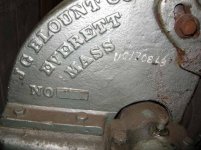Sometime I hate I am interested/addicted in old iron.
This Saturday I hit the salvage yard to get some plate to convert my sheet metal work bench into a welding workbench. I came around the corner to the incoming sorting pile and guess what was standing out in the middle calling to me in it's 750# silver painted glory...
A 12"x1.5" JG Blount pedestal grinder, serial no. 1553A. It has 2 stones, one wet and one dry and the pedestal is the water tank. Motor is missing along with the pulley for the water pump which seems jammed. I figure she was built 1910's -1930's, since the drive pulley and slack adjuster have a flat belt profile, and not V Belt, and the motor mount plate was cast in and not bolted on.
I am sure you all have gone through what I did for about 1/2 hour at the yard, arguing with yourself.



Do I need it, It's too good to be scrapped, do I have enough `tool' money, might I use it, it needs..., do I have room for it, I only came for X, can I get it safely off the truck, etc... You can guess the result.
Now for the real questions, does anyone else have one? What size motor would she have had (hp & RPM), I am thinking 3hp, 1200rpm, but the ghost of the motor footprint seems larger. Was the drive sheave the same size, larger or smaller than the driven one on the wheel shaft. What diameter pulley would have been on the motor and the pump for driving the water pump. How do I change out the wet wheel?
Enjoy the photos,
Thanks,
Rich C.

This Saturday I hit the salvage yard to get some plate to convert my sheet metal work bench into a welding workbench. I came around the corner to the incoming sorting pile and guess what was standing out in the middle calling to me in it's 750# silver painted glory...

A 12"x1.5" JG Blount pedestal grinder, serial no. 1553A. It has 2 stones, one wet and one dry and the pedestal is the water tank. Motor is missing along with the pulley for the water pump which seems jammed. I figure she was built 1910's -1930's, since the drive pulley and slack adjuster have a flat belt profile, and not V Belt, and the motor mount plate was cast in and not bolted on.
I am sure you all have gone through what I did for about 1/2 hour at the yard, arguing with yourself.



Do I need it, It's too good to be scrapped, do I have enough `tool' money, might I use it, it needs..., do I have room for it, I only came for X, can I get it safely off the truck, etc... You can guess the result.
Now for the real questions, does anyone else have one? What size motor would she have had (hp & RPM), I am thinking 3hp, 1200rpm, but the ghost of the motor footprint seems larger. Was the drive sheave the same size, larger or smaller than the driven one on the wheel shaft. What diameter pulley would have been on the motor and the pump for driving the water pump. How do I change out the wet wheel?
Enjoy the photos,
Thanks,
Rich C.
Attachments
Last edited:






 ...
...